2015.5 Peugeot 308 roof
[x] Cancel search: roofPage 4 of 396

.
.
Over view
Instrument panel 12
Indicator and warning lamps
1
3
ga
uges and indicators
2
8
Distance recorders
3
2
tr
ip computer
3
4
to
uch screen
3
7
Setting the date and time
4
4Remote control key
4
8
"Keyless e
n
try and Starting" with remote
control 54
"Keyless e
n
try and Starting"
on your person
5
6
Boot
59
Alarm
65
el
ectric windows
6
9
P
e
uge
Ot
i- Cockpit
7
1
Steering wheel adjustment
7
1
Front seats
7
2
Rear seats (hatchback)
7
7
Rear seats (SW)
7
8
Interior fittings
8
0
Front armrest 8 2
Boot fittings (hatchback)
8
6
Boot fittings (SW)
87
H
eating and Ventilation
9
0
Heating
9
2
Manual air conditioning
9
2
Manual air conditioning (
to
uch screen)
9
4
Dual-zone digital air conditioning (
to
uch screen)
9
6
Front demist - defrost
1
01
Rear screen demist - defrost
1
02
Panoramic sunroof
1
03
Courtesy lamps
1
04
Interior mood lighting
1
05Mirrors
10 6
Lighting control stalk
1
08
Direction indicators
1
11
Daytime running lamps
1
12
Automatic illumination of headlamps
1
12
Side spotlamps
1
14
Headlamp beam height adjustment
1
14
Wiper control stalk
1
15
Automatic rain sensitive wipers
1
17
Hazard warning lamps 1 19
em
ergency or assistance call
1
19
H or n
12
0
e
SC system
1
20
Seat belts
1
23
Airbags
1
26
Child seats
1
30
Deactivating the passenger's front airbag
1
33
ISOFIX mountings and child seats
1
39
Child lock
1
45
eco-driving
In struments Access
ea
se of use and comfort Lighting and visibility
Safety
Contents
Page 5 of 396
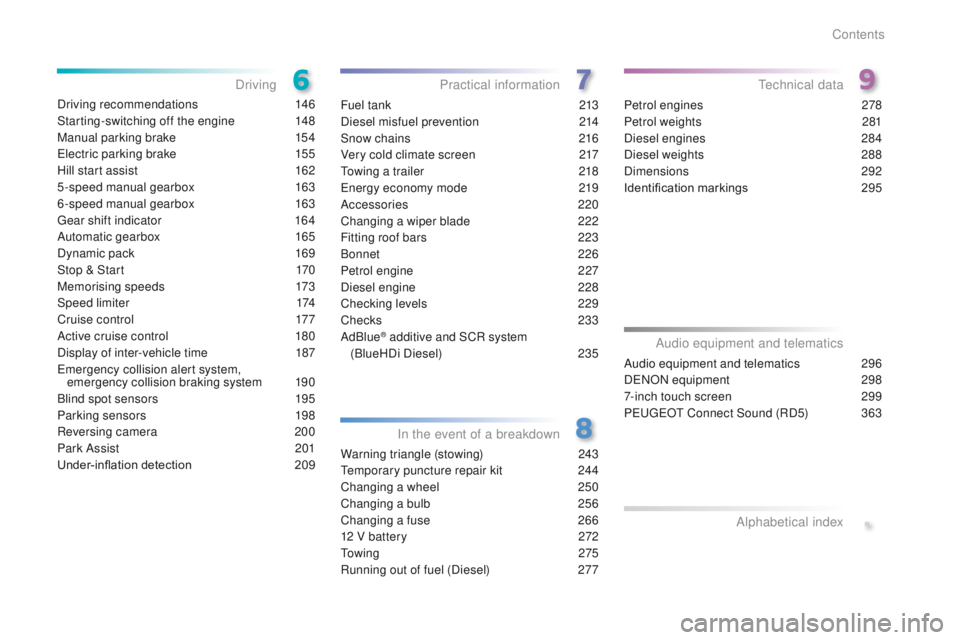
Driving recommendations 146
Starting-switching off the engine
1
48
Manual parking brake
1
54
el
ectric parking brake
1
55
Hill start assist
1
62
5-speed manual gearbox
1
63
6-speed manual gearbox
1
63
ge
ar shift indicator
1
64
Automatic gearbox
1
65
Dynamic pack
1
69
Stop & Start
1
70
Memorising speeds
1
73
Speed limiter
1
74
Cruise control
1
77
Active cruise control
1
80
Display of inter-vehicle time
1
87
em
ergency collision alert system,
emergency collision braking system
1
90
Blind spot sensors
1
95
Parking sensors
1
98
Reversing camera
2
00
Park Assist
2
01
Under-inflation detection
20
9Fuel tank
2 13
Diesel misfuel prevention
2
14
Snow chains
2
16
Very cold climate screen
2
17
to
wing a trailer
2
18
en
ergy economy mode
2
19
Accessories
2
20
Changing a wiper blade
2
22
Fitting roof bars
2
23
Bonnet
226
Petrol engine
2
27
Diesel engine
2
28
Checking levels
2
29
Checks
233
AdBlue
® additive and SCR system
(
BlueHDi Diesel)
23
5
Warning triangle (stowing)
2
43
te
mporary puncture repair kit
2
44
Changing a wheel
2
50
Changing a bulb
2
56
Changing a fuse
2
66
12 V battery
2
72
to
w i n g
2 7 5
Running out of fuel (Diesel)
2
77Petrol engines
2
78
Petrol weights
2
81
Diesel engines
2
84
Diesel weights
2
88
Dimensions
2
92
Identification markings
2
95
Driving
Practical information
In the event of a breakdownte chnical data
.
Audio equipment and telematics 296
D
eN
ON equipment
2
98
7-inch touch screen
2
99
Peuge
O
t Connect Sound (RD5)
3
63
Audio equipment and telematics
Alphabetical index
Contents
Page 6 of 396
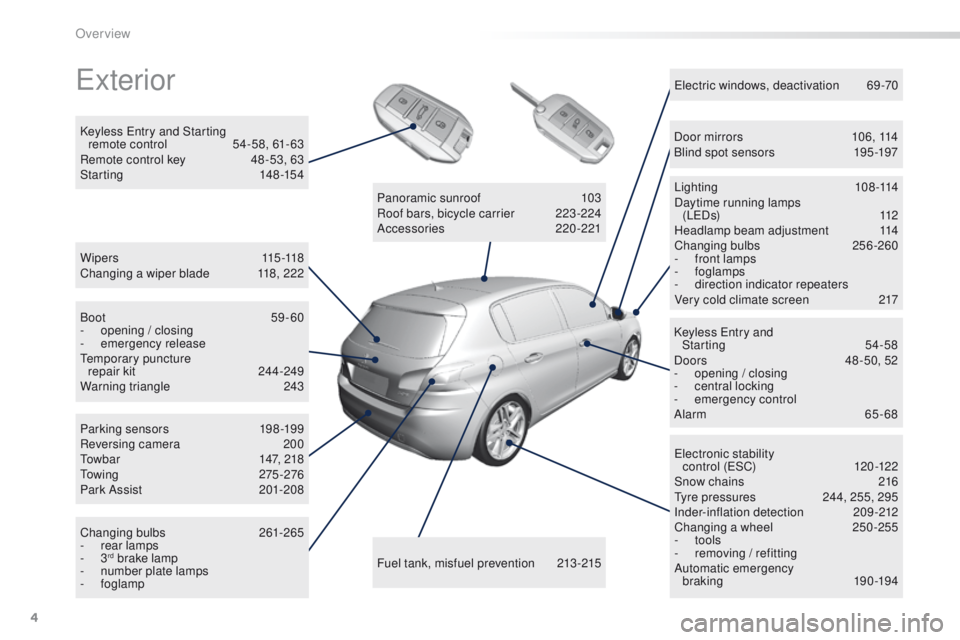
4
exterior
W i p e r s 115 -118
Changing a wiper blade 1 18, 222
Keyless
e
n
try and Starting
remote control
5
4-58, 61- 63
Remote control key
4
8 -53, 63
Starting
1
48-154
ele
ctronic stability
control (
e
SC)
1
20 -122
Snow chains
2
16
ty
re pressures
2
44, 255, 295
Inder-inflation detection
20
9-212
Changing a wheel
2
50-255
-
tools
-
r
emoving / refitting
Automatic emergency braking
19 0 -19 4
Lighting
108-114
Daytime running lamps (L e
D
s)
1
12
Headlamp beam adjustment
1
14
Changing bulbs 2 56-260
- f ront lamps
-
foglamps
-
d
irection indicator repeaters
Very cold climate screen
2
17
el
ectric windows, deactivation
6
9-70
Keyless e
n
try and
Starting
54-58
Doors
4
8 -50, 52
-
ope
ning / closing
-
c
entral locking
-
em
ergency control
Alarm
65-68
Fuel tank, misfuel prevention
2
13-215
Panoramic sunroof
1
03
Roof bars, bicycle carrier
2
23 -224
Accessories
2
20-221
Boot
59-60
-
ope
ning / closing
-
em
ergency release
te
mporary puncture
repair kit
2
44-249
Warning triangle
2
43
Parking sensors
1
98-199
Reversing camera
2
00
to
wbar
1
47, 218
to
wing
2
75 -276
Park Assist
2
01-208
Changing bulbs
2
61-265
-
r
ear lamps
-
3
rd brake lamp
-
n
umber plate lamps
-
foglamp Door mirrors
1
06, 114
Blind spot sensors
1
95 -197
Over view
Page 12 of 396
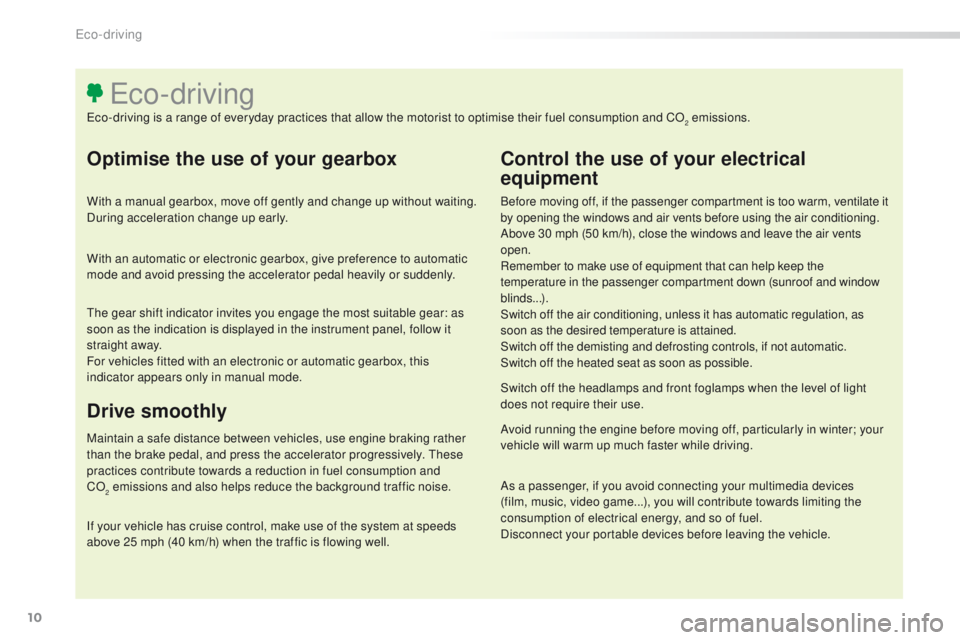
10
Optimise the use of your gearbox
With a manual gearbox, move off gently and change up without waiting.
During acceleration change up early.
With an automatic or electronic gearbox, give preference to automatic
mode and avoid pressing the accelerator pedal heavily or suddenly.
Control the use of your electrical
equipment
Before moving off, if the passenger compartment is too warm, ventilate it
by opening the windows and air vents before using the air conditioning.
Above 30 mph (50 km/h), close the windows and leave the air vents
open.
Remember to make use of equipment that can help keep the
temperature in the passenger compartment down (sunroof and window
blinds...).
Switch off the air conditioning, unless it has automatic regulation, as
soon as the desired temperature is attained.
Switch off the demisting and defrosting controls, if not automatic.
Switch off the heated seat as soon as possible.
Switch off the headlamps and front foglamps when the level of light
does not require their use.
Avoid running the engine before moving off, particularly in winter; your
vehicle will warm up much faster while driving.
As a passenger, if you avoid connecting your multimedia devices
(film, music, video game...), you will contribute towards limiting the
consumption of electrical energy, and so of fuel.
Disconnect your portable devices before leaving the vehicle.
eco-driving
eco-driving is a range of everyday practices that allow the motorist to optimise their fuel consumption and CO2 emissions.
Drive smoothly
Maintain a safe distance between vehicles, use engine braking rather
than the brake pedal, and press the accelerator progressively. th ese
practices contribute towards a reduction in fuel consumption and
CO
2 emissions and also helps reduce the background traffic noise.
I
f your vehicle has cruise control, make use of the system at speeds
above 25 mph (40 km/h) when the traffic is flowing well.
th
e gear shift indicator invites you engage the most suitable gear: as
soon as the indication is displayed in the instrument panel, follow it
straight away.
For vehicles fitted with an electronic or automatic gearbox, this
indicator appears only in manual mode.
Eco-driving
Page 13 of 396
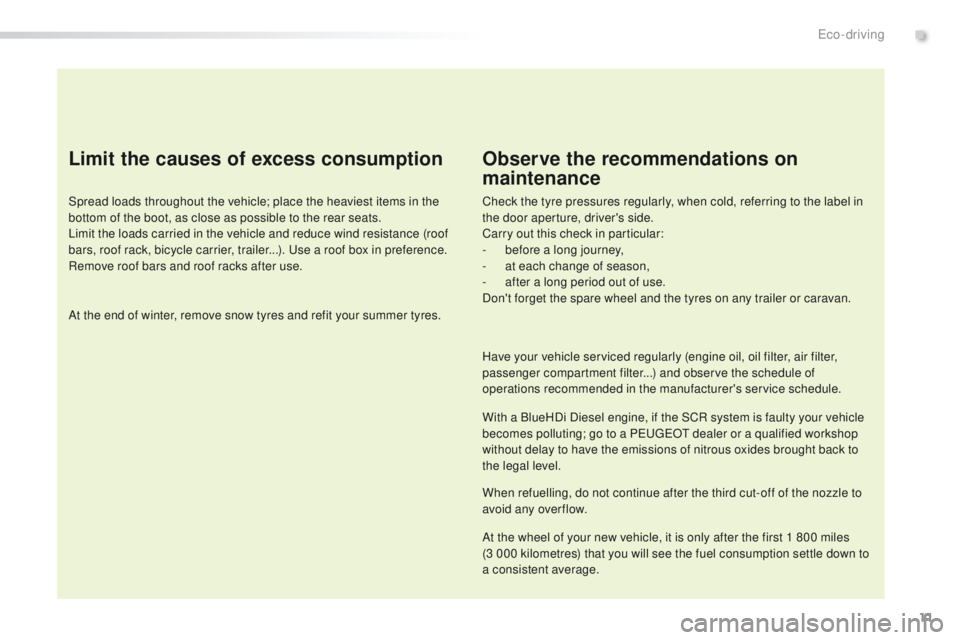
11
Limit the causes of excess consumption
Spread loads throughout the vehicle; place the heaviest items in the
bottom of the boot, as close as possible to the rear seats.
Limit the loads carried in the vehicle and reduce wind resistance (roof
bars, roof rack, bicycle carrier, trailer...). u
s
e a roof box in preference.
Remove roof bars and roof racks after use.
At the end of winter, remove snow tyres and refit your summer tyres.
Observe the recommendations on
maintenance
Check the tyre pressures regularly, when cold, referring to the label in
the door aperture, driver's side.
Carry out this check in particular:
-
b
efore a long journey,
-
a
t each change of season,
-
a
fter a long period out of use.
Don't forget the spare wheel and the tyres on any trailer or caravan.
Have your vehicle serviced regularly (engine oil, oil filter, air filter,
passenger compartment filter...) and observe the schedule of
operations recommended in the manufacturer's service schedule.
With a BlueHDi Diesel engine, if the SCR system is faulty your vehicle
becomes polluting; go to a P
e
uge
Ot
dealer or a qualified workshop
without delay to have the emissions of nitrous oxides brought back to
the legal level.
When refuelling, do not continue after the third cut-off of the nozzle to
avoid any over flow.
At the wheel of your new vehicle, it is only after the first 1 800 miles
(3
000 kilometres) that you will see the fuel consumption settle down to
a consistent average.
.
Eco-driving
Page 91 of 396
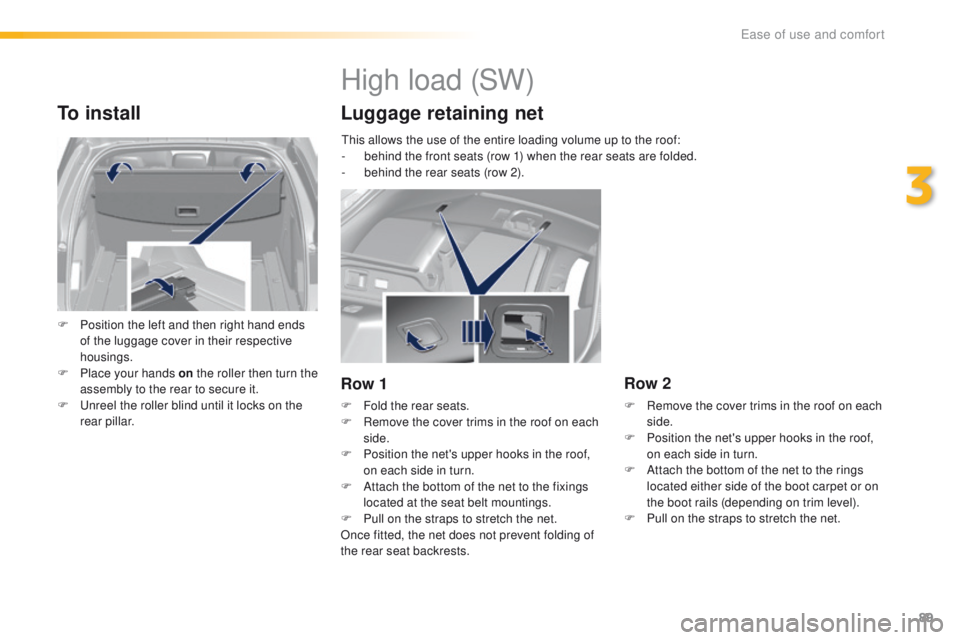
89
To install
F Position the left and then right hand ends of the luggage cover in their respective
housings.
F
P
lace your hands on the roller then turn the
assembly to the rear to secure it.
F
u
n
reel the roller blind until it locks on the
rear pillar.
High load (SW)
Luggage retaining net
Row 1
F Fold the rear seats.
F R emove the cover trims in the roof on each
side.
F
P
osition the net's upper hooks in the roof,
on each side in turn.
F
A
ttach the bottom of the net to the fixings
located at the seat belt mountings.
F
P
ull on the straps to stretch the net.
Once fitted, the net does not prevent folding of
the rear seat backrests.
Row 2
F Remove the cover trims in the roof on each side.
F
P
osition the net's upper hooks in the roof,
on each side in turn.
F
A
ttach the bottom of the net to the rings
located either side of the boot carpet or on
the boot rails (depending on trim level).
F
P
ull on the straps to stretch the net.
th
is allows the use of the entire loading volume up to the roof:
-
b
ehind the front seats (row 1) when the rear seats are folded.
-
b
ehind the rear seats (row 2).
3
Ease of use and comfort
Page 105 of 396
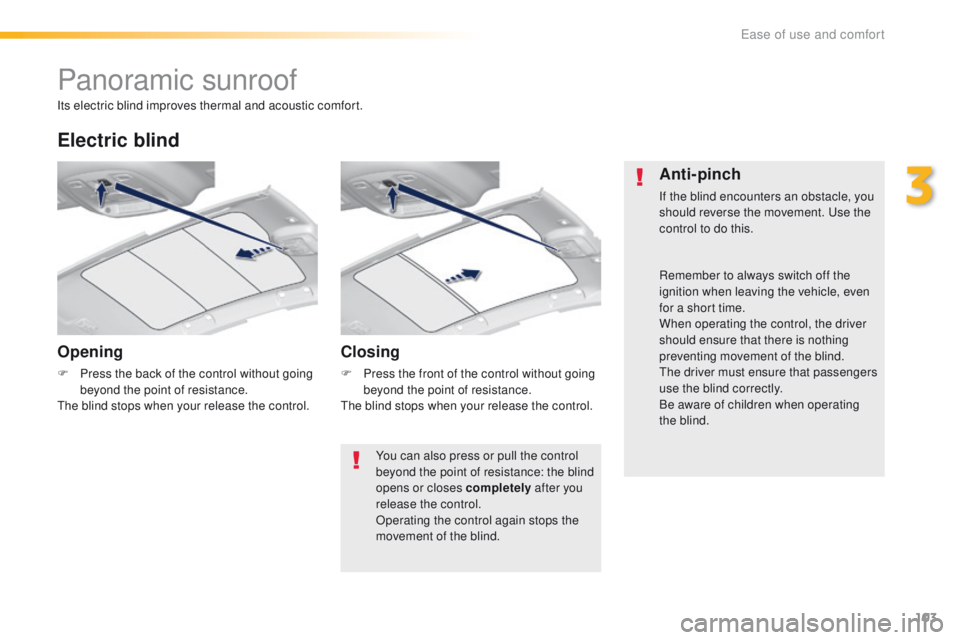
103
Panoramic sunroof
Opening
F Press the back of the control without going beyond the point of resistance.
the
blind stops when your release the control.
Electric blind
Closing
F Press the front of the control without going beyond the point of resistance.
the
blind stops when your release the control.
Anti-pinch
If the blind encounters an obstacle, you
should reverse the movement. use the
control to do this.
Its electric blind improves thermal and acoustic comfort.
You can also press or pull the control
beyond the point of resistance: the blind
opens or closes completely after you
release the control.
Operating the control again stops the
movement of the blind. Remember to always switch off the
ignition when leaving the vehicle, even
for a short time.
When operating the control, the driver
should ensure that there is nothing
preventing movement of the blind.
the
driver must ensure that passengers
use the blind correctly.
Be aware of children when operating
the blind.
3
ease of use and comfort
Page 131 of 396
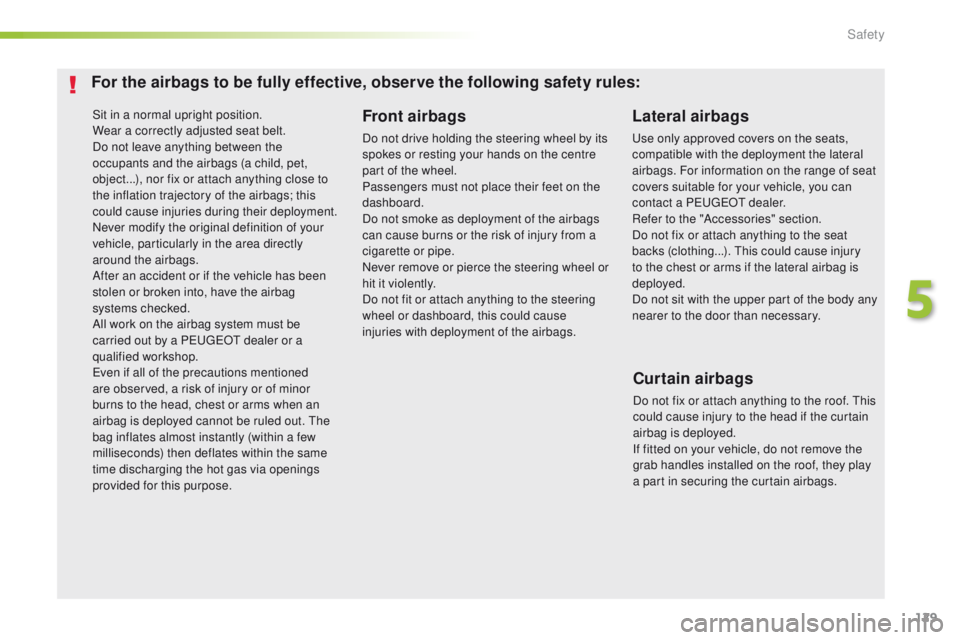
129
Sit in a normal upright position.
Wear a correctly adjusted seat belt.
Do not leave anything between the
occupants and the airbags (a child, pet,
object...), nor fix or attach anything close to
the inflation trajectory of the airbags; this
could cause injuries during their deployment.
Never modify the original definition of your
vehicle, particularly in the area directly
around the airbags.
After an accident or if the vehicle has been
stolen or broken into, have the airbag
systems checked.
All work on the airbag system must be
carried out by a P
e
uge
Ot
dealer or a
qualified workshop.
ev
en if all of the precautions mentioned
are observed, a risk of injury or of minor
burns to the head, chest or arms when an
airbag is deployed cannot be ruled out.
t
h
e
bag inflates almost instantly (within a few
milliseconds) then deflates within the same
time discharging the hot gas via openings
provided for this purpose.Lateral airbags
use only approved covers on the seats,
compatible with the deployment the lateral
airbags. For information on the range of seat
covers suitable for your vehicle, you can
contact a P
e
uge
Ot
dealer.
Refer to the "Accessories" section.
Do not fix or attach anything to the seat
backs (clothing...).
t
h
is could cause injury
to the chest or arms if the lateral airbag is
deployed.
Do not sit with the upper part of the body any
nearer to the door than necessary.
Front airbags
Do not drive holding the steering wheel by its
spokes or resting your hands on the centre
part of the wheel.
Passengers must not place their feet on the
dashboard.
Do not smoke as deployment of the airbags
can cause burns or the risk of injury from a
cigarette or pipe.
Never remove or pierce the steering wheel or
hit it violently.
Do not fit or attach anything to the steering
wheel or dashboard, this could cause
injuries with deployment of the airbags.
For the airbags to be fully effective, observe the following safety rules:
Curtain airbags
Do not fix or attach anything to the roof. this
could cause injury to the head if the curtain
airbag is deployed.
If fitted on your vehicle, do not remove the
grab handles installed on the roof, they play
a part in securing the curtain airbags.
5
Safety